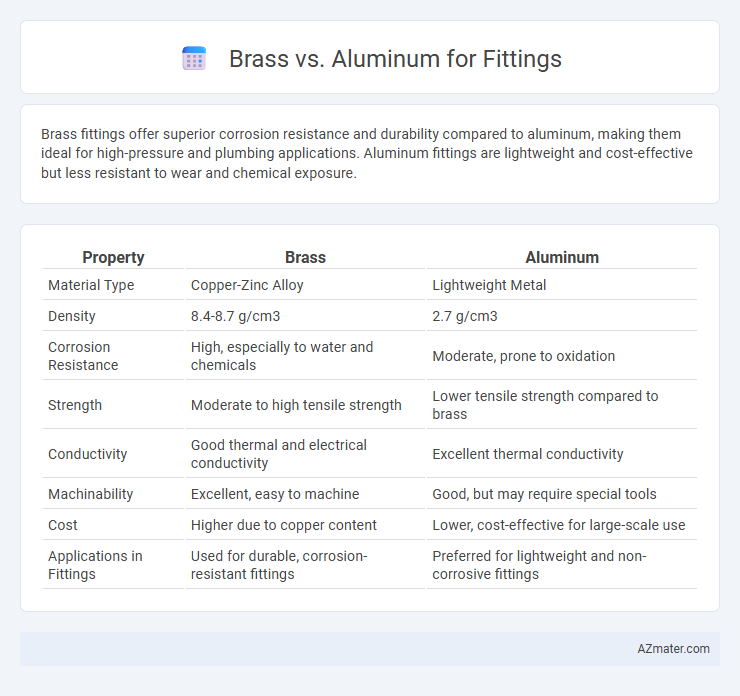Brass fittings offer superior corrosion resistance and durability compared to aluminum, making them ideal for high-pressure and plumbing applications. Aluminum fittings are lightweight and cost-effective but less resistant to wear and chemical exposure.
Table of Comparison
| Property | Brass | Aluminum |
|---|---|---|
| Material Type | Copper-Zinc Alloy | Lightweight Metal |
| Density | 8.4-8.7 g/cm3 | 2.7 g/cm3 |
| Corrosion Resistance | High, especially to water and chemicals | Moderate, prone to oxidation |
| Strength | Moderate to high tensile strength | Lower tensile strength compared to brass |
| Conductivity | Good thermal and electrical conductivity | Excellent thermal conductivity |
| Machinability | Excellent, easy to machine | Good, but may require special tools |
| Cost | Higher due to copper content | Lower, cost-effective for large-scale use |
| Applications in Fittings | Used for durable, corrosion-resistant fittings | Preferred for lightweight and non-corrosive fittings |
Introduction: Brass vs Aluminum Fittings
Brass fittings offer superior corrosion resistance and durability, making them ideal for plumbing and high-pressure applications, while aluminum fittings provide lightweight strength and excellent conductivity, suited for automotive and aerospace industries. Brass exhibits higher tensile strength and better sealing properties, contributing to leak-proof connections in harsh environments. Aluminum fittings excel in weight-sensitive projects due to their lower density and resistance to oxidation, promoting efficiency and longevity in thermal management systems.
Material Composition and Properties
Brass fittings are composed primarily of copper and zinc, offering excellent corrosion resistance, durability, and machinability, making them ideal for plumbing and industrial applications. Aluminum fittings, made from lightweight aluminum alloy, provide high strength-to-weight ratio and natural corrosion resistance but lack the same level of wear resistance as brass. The choice between brass and aluminum fittings depends on application requirements such as mechanical strength, environmental exposure, and conductivity.
Strength and Durability Comparison
Brass fittings exhibit superior strength and corrosion resistance compared to aluminum, making them ideal for high-pressure and high-temperature applications. Aluminum fittings, while lightweight and resistant to oxidation, are generally less durable under mechanical stress and prone to deformation. Choosing brass ensures enhanced longevity and reliability in demanding industrial environments.
Corrosion Resistance
Brass fittings demonstrate excellent corrosion resistance due to their copper and zinc alloy composition, making them suitable for potable water and marine environments where exposure to moisture is prevalent. Aluminum fittings, while lightweight and corrosion-resistant in certain contexts, are more susceptible to oxidation and may require protective coatings to prevent corrosion, especially in acidic or saline conditions. Brass maintains long-term durability without significant degradation, offering a reliable choice for fittings exposed to harsh or variable environmental factors.
Weight and Flexibility
Brass fittings are significantly heavier than aluminum, with brass weighing approximately 8.5 g/cm3 compared to aluminum's 2.7 g/cm3, making aluminum the preferred choice for applications requiring lightweight components. Aluminum offers superior flexibility and corrosion resistance, allowing for easier installation and durability in dynamic environments. Brass, while heavier and less flexible, provides higher strength and better resistance to wear, making it suitable for high-pressure fittings.
Cost Effectiveness
Brass fittings generally offer higher durability and corrosion resistance but come at a premium cost compared to aluminum fittings, which are lighter and more affordable. Aluminum fittings provide a cost-effective solution for applications with lower pressure requirements, balancing performance and budget. For long-term savings, brass is preferred in high-stress environments due to its longevity and reduced maintenance expenses.
Application Suitability
Brass fittings excel in high-pressure and high-temperature applications due to their superior durability, corrosion resistance, and mechanical strength, making them ideal for plumbing, gas, and hydraulic systems. Aluminum fittings offer lightweight properties and resistance to corrosion in low-pressure environments, making them suitable for applications such as automotive, aerospace, and HVAC systems where weight reduction is critical. Selecting between brass and aluminum fittings depends on the specific requirements of pressure tolerance, environmental exposure, and weight constraints in the intended application.
Installation and Maintenance
Brass fittings offer superior durability and corrosion resistance, making them easier to install in high-pressure and high-temperature systems with less risk of leaks or damage. Aluminum fittings are lightweight and easier to handle during installation but may require more frequent maintenance due to susceptibility to oxidation and wear. Choosing brass reduces long-term maintenance needs, while aluminum provides cost-effective installation benefits in less demanding applications.
Environmental Impact and Sustainability
Brass fittings typically have a higher environmental impact due to energy-intensive mining and smelting processes, but they offer excellent durability and recyclability, making them a sustainable choice over the long term. Aluminum fittings require less energy to produce and are highly recyclable, reducing their carbon footprint, yet they may have a shorter lifespan compared to brass. Choosing between brass and aluminum involves balancing the initial environmental cost with durability, recyclability, and lifecycle sustainability to minimize overall ecological impact.
Choosing the Right Fitting for Your Needs
Brass fittings offer superior corrosion resistance and durability, making them ideal for high-pressure and outdoor applications requiring long-lasting performance. Aluminum fittings provide a lightweight and cost-effective alternative, best suited for low-pressure environments and projects prioritizing ease of handling. Evaluating factors like pressure requirements, environmental exposure, and budget ensures selecting the right material for efficient and reliable fittings.

Infographic: Brass vs Aluminum for Fitting
 azmater.com
azmater.com